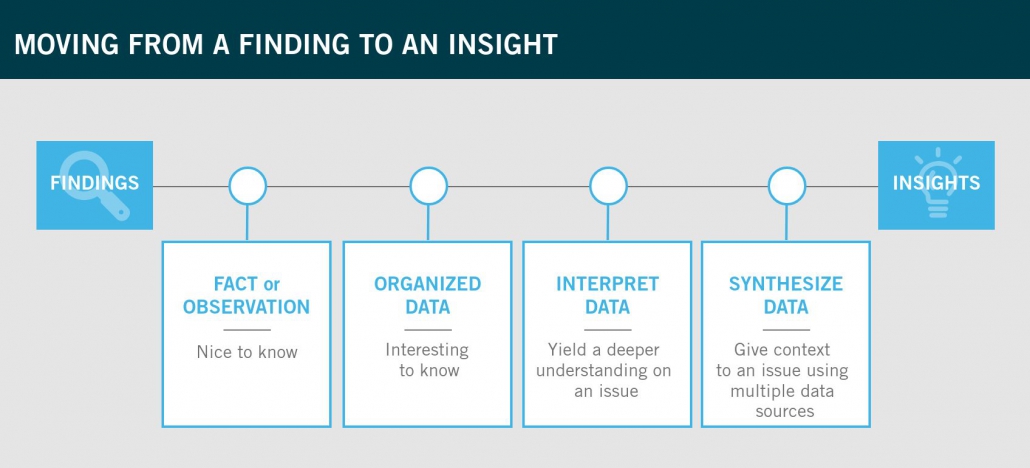
What is an Insight?
by Jim Berling
For several years I have had the pleasure of leading the Burke Institute seminar on report writing, which includes a two-hour session of instruction and discussion on expounding an insight, how to make an insight actionable through work sessions, and how best to convey an insight in a report. During this time, I’ve looked into the many ways in which organizations define an insight. Each organization brings different perspectives, based on their size, their industry, and their needs. These different points of view help to shape the content of the insight. It is our job to mold these varying perspectives into a single insight.


One way to think about an insight is along a continuum. On the left side of the continuum, we start with a fact or observation. As we move one step to the right, we combine facts into meaningful ways to analyze and interpret the data, beginning to identify new learnings for the organization. One step further to the right, we bring in additional data streams or other relevant data, such as financial data or organizational benchmarks, which begin to turn the finding into an opportunity for the company. At the end of the continuum, we build on the opportunity by linking it to business strategy and identifying actionable ways to leverage that opportunity. And now, you have an insight.
For example, let’s look at a concept test. We test three concepts and after running the study, we receive the following top-two box scores on a likelihood to purchase scale of 55%, 68%, and 66% respectively. These are the facts or observations.
The second step is to compare the results to determine the level of difference that exists between the three concept test scores. Next, we incorporate additional information to compare these purchase scores against some action standard that was designated prior to the study.
The results from our example test find two of the three concepts exceed our benchmark standard of 65%. Now, we look at any open-ended data, competitive products in the markets, or data from a TURF analysis, and discuss which of these two new concepts would best fit with our retail or trade promotional programs.
From here, we meet for an insights workshop and determine the third concept makes the best choice from a business standpoint and, therefore, move ahead with concept three!
Of course, all of this is easier said than done. Again, within each organization the definition of, and process to identify, an insight varies. I’d love to hear your thoughts on establishing insights, and how we can move as an industry beyond reporting bulleted facts and observations, and onto reporting insights as persuasive, actionable stories within executive summaries and reports.

With over 20 years of hands-on experience working with clients in 21 countries and as Managing Director at Burke Institute, Jim Berling is a lifelong coach of research and insights best practices. Jim is dedicated to helping clients enhance their research skills to better understand customers and leverage insights from their research in engaging and actionable ways.
If you would like to learn more about Burke Institute, please visit www.burkeinstitute.com
And to learn more about Burke Institute’s course on Writing & Presenting Marketing Research Reports, visit www.burkeinstitute.com.
As always, you can follow Burke, Inc. on our LinkedIn, Twitter, Facebook and Instagram pages.
Sources: Feature Image – ©nikomsolftwaer – stock.adobe.com








